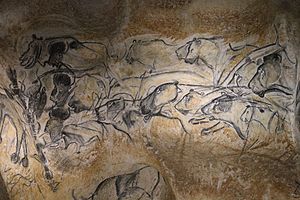History of Europe
History of Europe describes the passage of time in Europe, a continent that stretches from the Atlantic Ocean in the west to the Ural Mountains in the east, and from the Mediterranean Sea in the south to the Arctic Ocean in the north. Europe's history is characterized by a series of epochs and eras, marked by distinct cultural, political, and social changes.
Prehistoric Europe[edit | edit source]
The history of Europe begins with the prehistoric period, where the first Homo sapiens arrived in Europe approximately 40,000 years ago. This era, known as the Upper Paleolithic, saw the development of early human culture, art, and technology. Notable sites from this period include the Lascaux caves in France, famous for their cave paintings.
Classical Antiquity[edit | edit source]
Classical Antiquity in Europe is marked by the rise of the Greek civilization and its successor, the Roman Empire. The Greeks established the foundations of Western culture, philosophy, and democracy, particularly through city-states such as Athens. The Romans, on the other hand, contributed to law, politics, and engineering, leaving behind a legacy that would shape the future of Europe.
The Middle Ages[edit | edit source]
Following the fall of the Roman Empire, Europe entered the Middle Ages, a period that lasted from the 5th to the 15th century. This era was characterized by the spread of Christianity, the rise of feudalism, and the frequent conflicts between kingdoms. The Viking Age, the Crusades, and the Black Death were significant events that impacted European society during this time.
Renaissance and Exploration[edit | edit source]
The Renaissance was a period of rebirth in arts, science, and culture, originating in Italy in the 14th century and spreading across Europe. This era saw the emergence of figures such as Leonardo da Vinci and Michelangelo. Concurrently, the Age of Exploration led by explorers like Christopher Columbus and Vasco da Gama expanded European horizons and initiated direct contact with the Americas, Asia, and Africa.
Reformation and Religious Wars[edit | edit source]
The 16th century was marked by the Protestant Reformation, initiated by figures such as Martin Luther. This movement led to the division of Christianity and sparked a series of religious wars, including the Thirty Years' War, which devastated much of Europe.
The Enlightenment and Revolutions[edit | edit source]
The Enlightenment was an intellectual movement that emphasized reason, science, and individual rights. It set the stage for various revolutions, most notably the French Revolution, which radically changed the political landscape of Europe and led to the rise of Napoleon Bonaparte.
Industrial Revolution[edit | edit source]
The Industrial Revolution, beginning in the late 18th century, transformed Europe from agrarian societies into industrial powerhouses. This period saw significant technological advancements and social changes, leading to increased urbanization and economic growth.
20th Century and World Wars[edit | edit source]
The 20th century was marked by two world wars that had profound effects on Europe. World War I and World War II led to massive loss of life, the collapse of empires, and the redrawing of borders. The post-war period saw the division of Europe during the Cold War, the formation of the European Union, and the process of European integration.
Contemporary Europe[edit | edit source]
Today, Europe is characterized by its union of diverse nations, striving for political and economic cooperation while dealing with challenges such as migration, economic disparities, and the impacts of globalization. The continent continues to play a significant role in global affairs, culture, and science.
Search WikiMD
Ad.Tired of being Overweight? Try W8MD's physician weight loss program.
Semaglutide (Ozempic / Wegovy and Tirzepatide (Mounjaro / Zepbound) available.
Advertise on WikiMD
|
WikiMD's Wellness Encyclopedia |
| Let Food Be Thy Medicine Medicine Thy Food - Hippocrates |
Translate this page: - East Asian
中文,
日本,
한국어,
South Asian
हिन्दी,
தமிழ்,
తెలుగు,
Urdu,
ಕನ್ನಡ,
Southeast Asian
Indonesian,
Vietnamese,
Thai,
မြန်မာဘာသာ,
বাংলা
European
español,
Deutsch,
français,
Greek,
português do Brasil,
polski,
română,
русский,
Nederlands,
norsk,
svenska,
suomi,
Italian
Middle Eastern & African
عربى,
Turkish,
Persian,
Hebrew,
Afrikaans,
isiZulu,
Kiswahili,
Other
Bulgarian,
Hungarian,
Czech,
Swedish,
മലയാളം,
मराठी,
ਪੰਜਾਬੀ,
ગુજરાતી,
Portuguese,
Ukrainian
Medical Disclaimer: WikiMD is not a substitute for professional medical advice. The information on WikiMD is provided as an information resource only, may be incorrect, outdated or misleading, and is not to be used or relied on for any diagnostic or treatment purposes. Please consult your health care provider before making any healthcare decisions or for guidance about a specific medical condition. WikiMD expressly disclaims responsibility, and shall have no liability, for any damages, loss, injury, or liability whatsoever suffered as a result of your reliance on the information contained in this site. By visiting this site you agree to the foregoing terms and conditions, which may from time to time be changed or supplemented by WikiMD. If you do not agree to the foregoing terms and conditions, you should not enter or use this site. See full disclaimer.
Credits:Most images are courtesy of Wikimedia commons, and templates, categories Wikipedia, licensed under CC BY SA or similar.
Contributors: Prab R. Tumpati, MD





